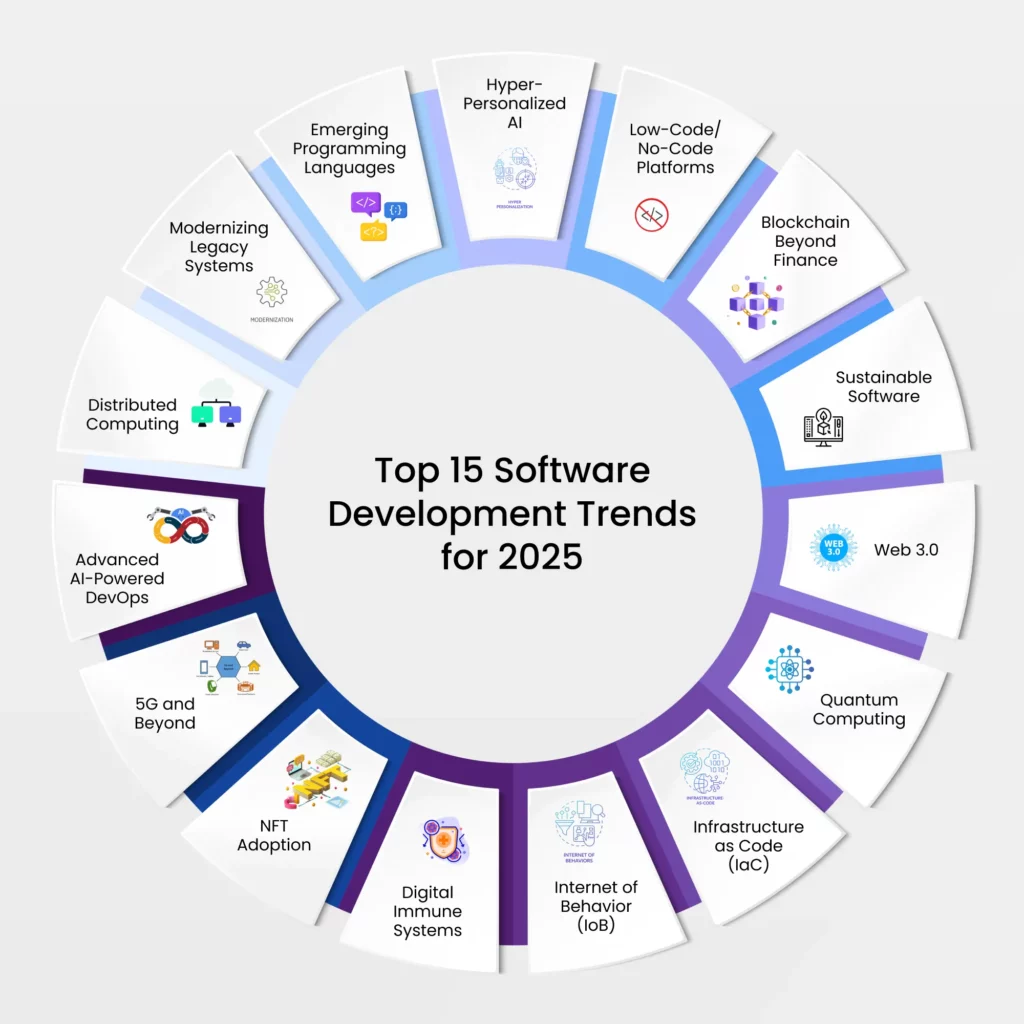Top Software Development Trends In 2025
It’s fascinating to think that in just a few years, AI-driven code generation might become as commonplace as word processors are today. The software landscape is evolving rapidly, with 2025 poised to witness unprecedented changes. With AI becoming increasingly proficient, developers could soon find themselves collaborating more with machines, elevating productivity levels to new heights.
In the realm of software development trends for 2025, automation and AI are undoubtedly leading the charge. Historically, software development required extensive human involvement, but that narrative is swiftly changing. It’s expected that by 2025, about 75% of coding will benefit from AI assistance. This transformation not only enhances efficiency but ensures that developers can focus on more creative tasks, pushing the boundaries of innovation further than ever before.

Emerging Role of AI in Software Development
AI is changing the way software development works by making things faster and smarter. Developers now use AI tools to help write and test code, which saves time. These tools can catch errors quickly, helping teams deliver better software. AI is also becoming a partner that suggests improvements developers might not have seen. This collaboration means better programs that work more efficiently.
An exciting part of AI in software is automation. Tasks that used to take a lot of time, like debugging, are now handled by AI. This means developers can focus more on designing creative solutions. By automating repetitive tasks, AI allows developers to innovate and try new ideas. It’s like having a helpful assistant that never gets tired!
AI also helps in predicting trends and making software that meets future needs. It can analyze user data to understand what people need in new apps and services. This prediction helps businesses stay ahead of the competition and meet user demands. AI’s ability to analyze big data ensures developers create relevant and successful software. With AI, teams can aim for software that matches user expectations perfectly.
Using AI in development also changes how teams work together. AI tools support teams by providing insights and recommendations in real-time. This means that even if a team is spread across different places, they can still collaborate effectively. AI fosters teamwork by ensuring everyone has access to the latest data and tools. As a result, software development becomes more efficient and unified.
Collaboration between AI and Programmers
AI and programmers working together create a powerful team that can tackle challenges more efficiently. While AI handles repetitive tasks, programmers can focus on designing innovative solutions. This collaboration allows for faster development cycles, benefiting both users and companies.
- AI helps find errors quickly, saving time.
- It suggests code improvements for better efficiency.
- AI learns from code patterns to offer smarter solutions.
With AI doing the heavy lifting, programmers can concentrate on more complex problems and creative tasks.
Programmers also train AI systems to perform specific tasks, enhancing the AI’s capabilities over time. The more data AI receives, the better it understands and predicts potential issues. By feeding AI with quality data, the collaboration results in robust and reliable software. This partnership keeps evolving as AI gets smarter with continuous learning. It’s a growing cycle, where both AI and developers benefit from each other’s strengths.
Another benefit of collaboration between AI and programmers is the improved design of user experiences. AI can analyze user feedback and behavior to give insights into what users need. By leveraging these insights, programmers can create software that directly meets user expectations. This makes the applications not only efficient but also user-friendly. With AI’s data-driven approach, developers can design interfaces that are both engaging and intuitive.
While AI assists programmers, there is still room for human intuition and creativity. Certain tasks require unique human insights that AI alone cannot provide. This balance ensures that while AI boosts productivity, human elements like creativity and critical thinking remain central. Combining both AI and human ingenuity makes for the best results in software development. The future is bright with this collaborative approach, leading to innovations that might have seemed impossible before.
The Rise of Automation in Coding
Automation in coding is transforming how programmers work and build software. By using automated tools, developers can speed up repetitive tasks, saving valuable time. These tools help identify and fix bugs faster, ensuring software quality remains high. Automation makes processes like testing more efficient and reliable. It’s like having an extra pair of hands that is always ready to help.
Various automated coding tools are now available to streamline the development process.
- Code review tools check for errors in the program.
- Testing tools automate the testing of software functions.
- Deployment tools make software release quicker and smoother.
Using these tools, teams can focus more on problem-solving and creative innovations. Automation frees up their time to dive deeper into complex challenges.
The impact of automation is seen in enhanced productivity among developers. Automation tools handle mundane tasks, allowing programmers to focus on core development work. This means faster project completion and quicker delivery of features to the market. The continuous integration of automation in coding is reshaping the software industry. Increased productivity leads to more competitive products and happier clients.
Despite the advantages, human touch and judgment are still crucial for successful software development. Machines might handle tasks efficiently, but human insights are necessary for creativity. Programmers understand the nuances of user experiences and design that AI may miss. Balancing automation with human input leads to the best outcomes. As technology advances, this blend will open up even more possibilities in software development.
Significant Increase in Efficiency Levels
The adoption of technology in various sectors has led to a significant increase in efficiency levels. Automation tools help businesses complete tasks faster, reducing the time it takes from planning to execution. Workers now focus on creative problem-solving, leaving routine tasks to machines. This shift not only boosts productivity but also energizes employees as they engage in more meaningful work. The result is a dynamic and efficient work environment.
Incorporating technology has particularly benefited industries like manufacturing and software development. With precision tools and automated systems, production lines run smoothly with minimal human error. Automated software testing eliminates bugs early, ensuring high-quality outputs.
- Manufacturing sees reduced downtime.
- Software projects face fewer delays.
- Quality and consistency remain high across outputs.
These advancements highlight the advantages of embracing technology for increased efficiency.
Efficiency improvements also lead to cost savings. Companies can produce more with less manpower, reducing operational expenses. This approach allows businesses to allocate resources more effectively, supporting growth and innovation. With the extra funds, companies can invest in research and development. This reinvestment fuels further advancements and competitive advantages.
The retail sector has witnessed a transformation too, with efficiency gains enhancing customer experiences. Automated checkout lanes speed up transactions, reducing waiting times for shoppers. Online platforms enable instant communication between sellers and buyers, ensuring seamless customer service. Customers appreciate faster, more personalized experiences, leading to greater satisfaction. Higher satisfaction levels translate to customer loyalty and repeat business.
Despite these gains, human input remains crucial to balance technology. While machines increase efficiency, humans bring creativity and empathy to the table. Collaborative efforts between technology and employees ensure the highest standards are met. This partnership creates a robust system capable of adapting to future challenges. As efficiency rises, so does the potential for greater achievements.
Focusing on More Creative Tasks in Software Development
With recent advancements in automation, developers can now shift their attention toward more creative tasks. These automation tools handle routine work, freeing up time for developers to think outside the box. Creativity in software development drives innovation, leading to more exciting and user-friendly applications. This change means developers spend less time debugging and more time experimenting with new ideas. As a result, the software industry is poised for rapid growth and novel creations.
One key area where creativity can flourish is in user interface (UI) and user experience (UX) design. Developers can now dedicate more effort to making software intuitive and enjoyable to use.
- Focused design enhances user satisfaction.
- Increased time for testing user journeys.
- Opportunities to incorporate user feedback quickly.
Improved UI/UX design can make applications not only beautiful but also highly functional, offering a seamless experience for users.
Customizing and personalizing software to meet specific client needs is another exciting creative task. With the basics managed by automation, developers can tailor applications to offer unique features. This personalization can include industry-specific tools, enhanced security measures, or bespoke integrations. By tapping into this creative freedom, developers deliver highly specialized software solutions. End-users benefit from applications that precisely meet their requirements, boosting productivity and satisfaction.
Collaboration is also enhanced when developers focus on creative tasks. Working together, teams can brainstorm and develop innovative solutions more effectively. Automation helps ensure that the groundwork is done, allowing team meetings to center on problem-solving and ideas. This dynamic fosters a vibrant, collaborative environment where innovation thrives. When developers harness their creativity collectively, the potential for groundbreaking software solutions multiplies.
Finally, focusing on creative tasks allows for continuous learning and growth. As developers push boundaries and explore new technologies, they gain valuable skills and knowledge. This constant learning keeps developers motivated and engaged in their work. It also ensures that they stay up-to-date with industry trends, enhancing their ability to innovate. Embracing creativity in software development leads to a more interesting and fulfilling career path for developers.
Potential Impact of these Trends on Innovation in Software Development
The current trends in software development are reshaping the landscape of technology by encouraging innovation. With automation and AI, developers can explore new frontiers without being bogged down by repetitive tasks. This innovation allows teams to create cutting-edge applications faster. Developers can now experiment with new designs and functionalities with greater freedom. The result is a dynamic and evolving tech sector that continuously pushes boundaries.
AI integration is unlocking new possibilities in how software solutions are developed and deployed. AI technology aids in predicting user behavior, allowing developers to create software that anticipates user needs.
- AI refines and personalizes user experiences.
- Predictive analytics help forecast trends.
- Intelligent systems adapt to changing requirements.
These sophisticated abilities lead to software that is not just reactive but proactive, making it more valuable and relevant.
Moreover, the rise of automation provides developers with more time to iterate and improve their projects. By automating testing and deployment, teams can release new features more frequently. This speed enhances responsiveness to user feedback, encouraging constant improvement. It promotes a culture of continuous development and innovation within tech companies. Faster turnaround times mean that users benefit from updates more swiftly.
As these trends continue, industry collaboration is becoming more streamlined. Development teams can now use shared platforms and tools to work together effortlessly. This collaboration fosters the exchange of ideas and technologies between different organizations. Enhanced teamwork leads to innovative solutions that can address complex challenges in software design. When multiple minds collaborate effectively, the potential for groundbreaking work increases manifold.
The potential impact of these trends on innovation is substantial. Not only do they ensure that software development is faster and more efficient, but they also encourage innovation by allowing developers to focus on creative and strategic tasks. Developers equipped with powerful tools can focus on innovating rather than just coding. Innovations in software development have the potential to change the way people interact with technology. As these trends evolve, they will undoubtedly continue to drive advancements in the tech industry.
Embracing the Future of Software Development
The trends shaping software development, like AI and automation, are setting the stage for remarkable innovation. By taking over repetitive tasks, these technologies provide developers with the space to focus on creativity. This shift promises not just faster development but also high-quality applications that meet evolving user needs. As developers embrace these tools, the potential for groundbreaking solutions expands.
Collaboration, enhanced by these technological advancements, enables teams to push the boundaries of what’s possible. By working together across platforms, developers can bring diverse ideas to life efficiently. As the tech industry continues to evolve, staying adaptable and innovative will be key. By embracing change, developers can lead the charge into a future brimming with possibilities.

